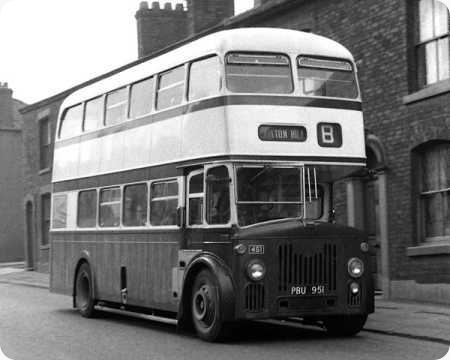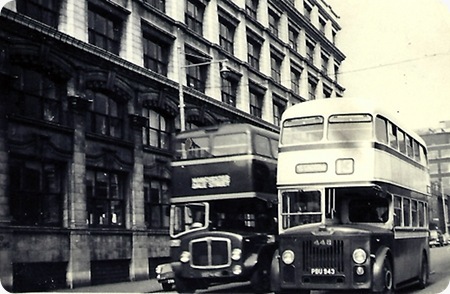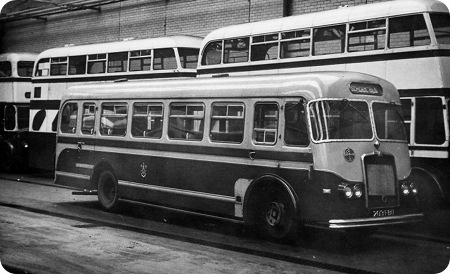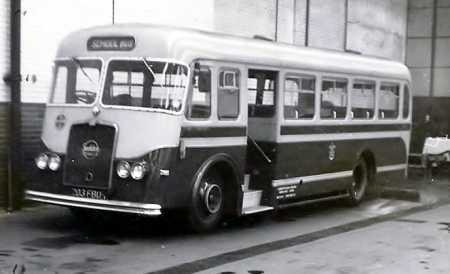Oldham Corporation – Leyland Titan – PBU 951 – 451
Oldham Corporation
1958
Leyland Titan PD2/30
Roe H35/28R
I Would like to contribute the above photo of Oldham Corporation 451 taken after its first repaint – so minus the waistrail white stripe and the intricate lining out (abandoned when these vehicles were repainted in 1965). The interior paintwork was changed also from the original hammered metal finish to a plain cream finish on the majority of the buses.
The first example of this batch to receive a repaint was 439, in January 1965, after substantial repairs following a serious front end collision the previous summer, when it had ploughed into a terraced house on Manchester Road whilst operating on route 98. The Oldham Chronicle carried a story with a photo of 439 embedded in the house with its crumpled bodywork surrounded a pile of bricks. No one was injured apparently.
I well remember riding on it from school to home one evening in January 1965 on the B (later 21) route.
Photograph and Copy contributed by David Butterworth
A full list of Titan codes can be seen here.
———
23/01/12 – 07:52
These buses were a great favourite of mine. The Roe bodies were very well appointed and in the original livery with the red lining out they looked very classy. I rode on them frequently on the 9 route from Rochdale travelling to Watersheddings to watch the rugby. They were extremely comfortable and smooth riding. Oldham had a good team in those days and invariably beat Rochdale Hornets in the local derbies.
I agree the buses lost a bit of their class in the simplified livery, initially retaining the original maroon to be replaced later by the Pommard and Cream livery which Oldham adopted up to absorption into SELNEC. I understand there were problems with the maroon fading which led to the ultimate change to the purpley red shade of Pommard. Like most of the Manchester area half-cabs they didn’t look too good in the SELNEC orange and white.
They had a fair turn of speed and were much faster than Rochdale’s Gardner engined Regent V’s which often operated the Rochdale share of the 9 route which was jointly operated by Ashton, Oldham and Rochdale Corporations.
They also worked on the 24/90 Limited Stop service between Rochdale and Manchester where they could show their paces to good effect, particularly on the 90 which ran non-stop between Royton and Manchester.
The Roe bodied examples of Oldham’s large fleet of PD2’s always seemed to be a cut above the Northern Counties and Crossley bodied examples and there was definitely no contest with the Metro-Cammell Orions which were positively spartan by comparison.
The photo also shows us that Oldham was among the small band of operators that used route letters for some of their services. To set the hare running I can bring to mind others as Middlesbrough, Portsmouth and Exeter. I am sure someone will soon add some more!
Philip Halstead
———
23/01/12 – 10:15
Yorkshire Woollen District used route letters on their Dewsbury area tram replacement services.
John Stringer
———
24/01/12 – 05:57
Lettered bus routes sometimes came about when the bus routes came along in conjunction with the trams. The trams had the numbers, so the buses got the letters.
I’m intrigued about a reverse situation with Cheltenham, which always had route numbers, tram and bus, but, at some point, in recent years, changed over to letters.
Bizarre!
Chris Hebbron
———
24/01/12 – 15:45
Mexborough and Swinton used route letters until the trolleybuses were phased out in March, 1961, at which time they switched over to numbers.
Rotherham Corporation ran jointly on the trolleybus routes to Mexborough and Conisborough, the Rotherham saloons showing either 8 or 9, and the Mexboro’ Sunbeams ‘A’ or ‘B’ respectively, until the changeover.
Dave Careless
———
24/01/12 – 15:46
I seem to remember (from 1956) that Great Yarmouth had a mix of lettered and numbered routes. I think all the lettered ones went to Gorlestone, but not all Gorlestone services were lettered ones. I have the distinct memory that route 3 started from Newtown on the northern edge of Yarmouth, and terminated at "Gorlestone (Green Ace)" – presumably a hostelry!
Stephen Ford
———
25/01/12 – 13:14
Middlesbrough Corporation also used route letters. Teesside Municipal Transport carried on this tradition for a number of years.
Stephen Bloomfield
———
20/02/12 – 13:38
Cheltenham switched to letters in the late 1980s when the Gloucester and Swindon operation was separated from Bristol. Both Gloucester and Cheltenham started minibus operations under the Metro name, and to avoid confusion Gloucester went for numbered routes and Cheltenham went for lettered. The one Cheltenham town route that kept a number for a while longer was the Prestbury-town-Coronation Square route 2 (which had full sized buses), but that eventually became the A.
James McLaren
———
20/02/12 – 17:12
Thx, James, for the answer to my question. A strange decision, really, since that neither towns’ local services ever strayed beyond their boundaries before or after minibuses came along. Still, it makes for variety. Does anyone know of any other bus companies currently using lettered routes?
Chris Hebbron
———
21/02/12 – 07:15
The Hebden Bridge local services supported by Metro and operated by Tyrer Tours use letters A – E. These were introduced in 2003 when First commenced operating the revised services with Optare Solos and Aleros supplied by Metro.
Ian Wild
———
21/02/12 – 07:18
Stagecoach Devon’s Exeter city services are still designated by letters, and it seems that to a large extent they are the initial letters of the suburbs to which they run – e.g. P – Pennsylvania; A – Alphington.
Stephen Ford
———
12/01/13 – 16:15
Try Preston corporation buses. Fp was Farringdon Park and there would have been others.
Andrew
Quick links to the - Comments Page - Contact Page - Home Page




